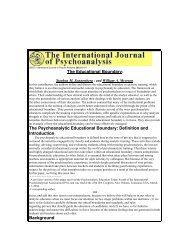A Companion to Linear B - The University of Texas at Austin
A Companion to Linear B - The University of Texas at Austin
A Companion to Linear B - The University of Texas at Austin
You also want an ePaper? Increase the reach of your titles
YUMPU automatically turns print PDFs into web optimized ePapers that Google loves.
58 T.G. PALAIMA §12.1.2.1.1<br />
are associ<strong>at</strong>ed with these women 44 and wh<strong>at</strong> look like phonetically abbrevi<strong>at</strong>ed<br />
entries (TA and DA). Here Bennett had identified tablets like Aa 792 as the<br />
work <strong>of</strong> Hand 1.<br />
Other tablets (series Ab) list the loc<strong>at</strong>ion <strong>of</strong> the women, their place <strong>of</strong> origin<br />
and/or work specialis<strong>at</strong>ion, numbers <strong>of</strong> boys and girls, and then quantities <strong>of</strong><br />
grain and figs, and the abbrevi<strong>at</strong>ions TA and DA. Ab 189 and all other Ab tablets<br />
are the work <strong>of</strong> Hand 21.<br />
Still other tablets (series Ad) differenti<strong>at</strong>e between older and younger<br />
pre-adult males among the children associ<strong>at</strong>ed with the different women<br />
work groups. <strong>The</strong>y specify th<strong>at</strong> these pre-adult males are ‘<strong>of</strong>’ the women<br />
design<strong>at</strong>ed on the tablets. Ad 683 and all other Ad tablets are the work <strong>of</strong><br />
Hand 23.<br />
Finally two clay labels by Hand 1 (Wa 114 and Wa 1008) refer explicitly<br />
<strong>to</strong> one <strong>of</strong> the two major provinces <strong>of</strong> the terri<strong>to</strong>ry <strong>of</strong> which the Palace <strong>of</strong> Nes<strong>to</strong>r<br />
<strong>at</strong> Pylos is the principal pal<strong>at</strong>ial centre. <strong>The</strong> labels also specify th<strong>at</strong> the foodstuffs<br />
allotted in the Ab texts are ‘monthly r<strong>at</strong>ions’ (me-ni-jo, menion) and th<strong>at</strong><br />
the women somehow here are receiving, or have received, si-<strong>to</strong>, si<strong>to</strong>s, i.e.,<br />
‘food’ or ‘grain’.<br />
In Figure 12.14, we may observe drawings <strong>of</strong> these tablets 45 <strong>of</strong> series Aa<br />
(Aa 792 Hand 1), Ad (Ad 683 Hand 23), and Ab (Ab 189 Hand 21) and the<br />
two transport or filing labels associ<strong>at</strong>ed with this series (Wa 1008 and Wa 114<br />
Hand 1). Tablet Aa 792 serves as a kind <strong>of</strong> census. It does not design<strong>at</strong>e the<br />
loc<strong>at</strong>ion <strong>of</strong> the women and children being counted and recorded. <strong>The</strong> scribe<br />
here (Hand 1) assumes and knows th<strong>at</strong> these women are ‘<strong>at</strong> Pylos’ (as they are<br />
design<strong>at</strong>ed here on the texts <strong>of</strong> Hands 23 and 21).<br />
On all three tablets the women are identified by wh<strong>at</strong> we might call ‘placename<br />
adjectives’. <strong>The</strong>se adjectives are tricky <strong>to</strong> work with because we do not<br />
know for this period whether in fact the women themselves would claim th<strong>at</strong><br />
they were ki-ni-di-ja ‘women <strong>of</strong> Knidos’ in ethnicity, or whether the word<br />
ki-ni-di-ja simply identifies for the pal<strong>at</strong>ial administra<strong>to</strong>rs <strong>at</strong> Pylos the area (in<br />
Ana<strong>to</strong>lia) from which the women came <strong>to</strong> Pylos. This would not imply th<strong>at</strong><br />
they were residents or inhabitants <strong>of</strong> Knidos and the terri<strong>to</strong>ry <strong>of</strong> Knidos. <strong>The</strong>y<br />
could, for example, have been g<strong>at</strong>hered, forcibly or willingly, from elsewhere<br />
in Ana<strong>to</strong>lia, near <strong>to</strong> or far from Knidos.<br />
Tablet Ad 683 differenti<strong>at</strong>es between male children <strong>of</strong> two different age<br />
groups, one called ko-wo, korwoi ‘boys’ and the other, older group, called<br />
44 We do not know th<strong>at</strong> all or any <strong>of</strong> these non-adult males and females are the biological children<br />
<strong>of</strong> these women.<br />
45<br />
CHADWICK 1988, 50, Group 9.

















